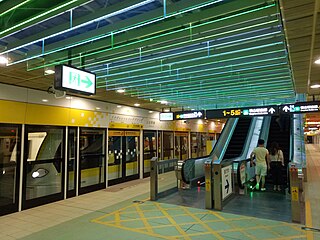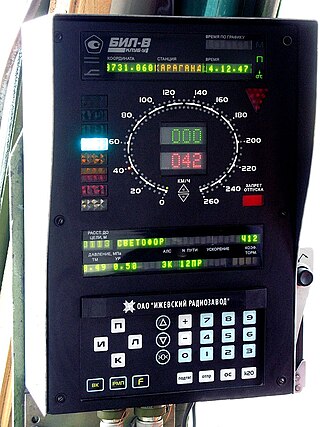
The Copenhagen Metro is a light rapid transit system in Copenhagen, Denmark, serving the municipalities of Copenhagen, Frederiksberg, and Tårnby.

The Cambrian Line, sometimes split into the Cambrian Main Line and Cambrian Coast Line for its branches, is a railway line that runs from Shrewsbury, England, westwards to Aberystwyth and Pwllheli in Wales. Passenger train services are operated by Transport for Wales Rail between the western terminals of Pwllheli, in Gwynedd, and Aberystwyth, in Ceredigion, and the eastern terminal at Shrewsbury, Shropshire, as part of the Wales & Borders franchise. The railway line is widely regarded as scenic, as it passes through the Cambrian Mountains in central Wales, and along the coast of Cardigan Bay in Snowdonia National Park.
Hitachi Rail Italy S.p.A. was a multinational rolling stock manufacturer company based in Pistoia, Italy. Formerly AnsaldoBreda S.p.A., a subsidiary of state-owned Finmeccanica, the company was sold in 2015 to Hitachi Rail of Japan. After the deal was finalized, the current name was adapted in November 2015 to reflect the new ownership.

The Circular or Yellow line is a metro line in New Taipei City, part of the New Taipei Metro, which was previously a line of the Taipei Metro. Currently the line runs between Dapinglin and New Taipei Industrial Park, it is approximately 15.4 km (9.6 mi) long with 14 stations. This initial section was opened on 31 January 2020. Hitachi Rail Italy supplied 17 sets of 4-car driverless medium-capacity trains for the line. Extensions to the north and south are currently under construction.

The European Train Control System (ETCS) is a train protection system designed to replace the many incompatible systems used by European railways, and railways outside of Europe. ETCS is the signalling and control component of the European Rail Traffic Management System (ERTMS).

Union Switch & Signal was an American company based in Pittsburgh, Pennsylvania, which focused on railway signaling equipment, systems and services. The company was acquired by Ansaldo STS in 1988, operating as a wholly-owned company until January 2009, when US&S was renamed "Ansaldo STS USA" to operate as a subsidiary of Ansaldo in the Americas and Asia.

The Genoa Metro is a light rapid transit system consisting of a single line that connects the centre of Genoa, Italy with the suburb of Rivarolo Ligure, to the north-west of the city centre. The service is currently managed by Azienda Mobilità e Trasporti (AMT), which provides public transport for the city of Genoa.

The Italian railway system is one of the most important parts of the infrastructure of Italy, with a total length of 24,227 km (15,054 mi) as of 2011.
The European Rail Traffic Management System (ERTMS) is the system of standards for management and interoperation of signalling for railways by the European Union (EU). It is conducted by the European Union Agency for Railways (ERA) and is the organisational umbrella for the separately managed parts of

The Brescia Metro is a rapid transit network serving Brescia, Lombardy, Italy. The network consists of a single line, having a length of 13.7 kilometres (8.5 mi) and a total of 17 stations from Prealpino to Sant’Eufemia-Buffalora, located respectively at the north and southeast of Brescia.
Hitachi, Ltd. Railway Systems Business Unit, trading as Hitachi Rail, is the rolling stock and railway signalling manufacturing division of Hitachi outside Japan.
Interoperable Communications Based Signaling (ICBS) is an initiative backed by the Federal Railroad Administration to enhance interoperability and signaling procurement in the railway system of the United States by creating a single national standard for train control and command systems. The concept was launched in 2005 and an interoperable prototype system was successfully demonstrated in January 2009.

The Hitachi Rail Italy Driverless Metro is a class of driverless electric multiple units and corresponding signaling system. Manufactured by Hitachi Rail Italy and Hitachi Rail STS in Italy, it is or will be used on the Copenhagen Metro, a people mover at Princess Nourah Bint Abdul Rahman University, the Brescia Metro, the Thessaloniki Metro, lines 4 and 5 of the Milan Metro, Line C of the Rome Metro, Skyline in Honolulu, and the Circular line of the New Taipei Metro. The first system to use this class of driverless electric multiple units was the Copenhagen Metro which was opened in 2002.

Line 5 is an underground rapid transit line in Milan, Italy, part of the Milan Metro. The line, also known as M5 or the Lilac Line, is 12.8-kilometre (8.0 mi) long and goes through the city from the north to the north-west. It opened in stages between 2013 and 2015.
Ansaldo Energia is an Italian engineering company.
ERTMS Regional is a simplified and low-cost variant of the European Rail Traffic Management System suitable for train control on lines with low traffic volumes. It is intended to reduce the amount of lineside and equipment required, thus reducing costs, increasing reliability and improving safety for track workers.

KLUB is the name of the modern Russian train control systems. The abbreviation "КЛУБ" stands for "Комплексное локомотивное устройство безопасности", Integrated Train Protection System.

The Frecciarossa 1000 is a high-speed train operated by Italian state railway operator Trenitalia and the private Spanish high-speed rail operator Iryo. It was co-developed as a joint venture between Italian rail manufacturer Hitachi Rail Italy and multinational conglomerate Alstom. Both design and production work were divided between the two partner companies.

The New Taipei Metro Circular Line EMU is a medium-capacity train operating on Taipei Metro's Circular line. A total of 17 4-car trains were manufactured by Hitachi Rail Italy in Reggio Calabria, then shipped to Hsinchu for final assembly at Taiwan Rolling Stock Company (TRSC). This is the second time Taiwan has purchased trains made in Italy after Taiwan Railways' EMU300 series, built by Socimi.












